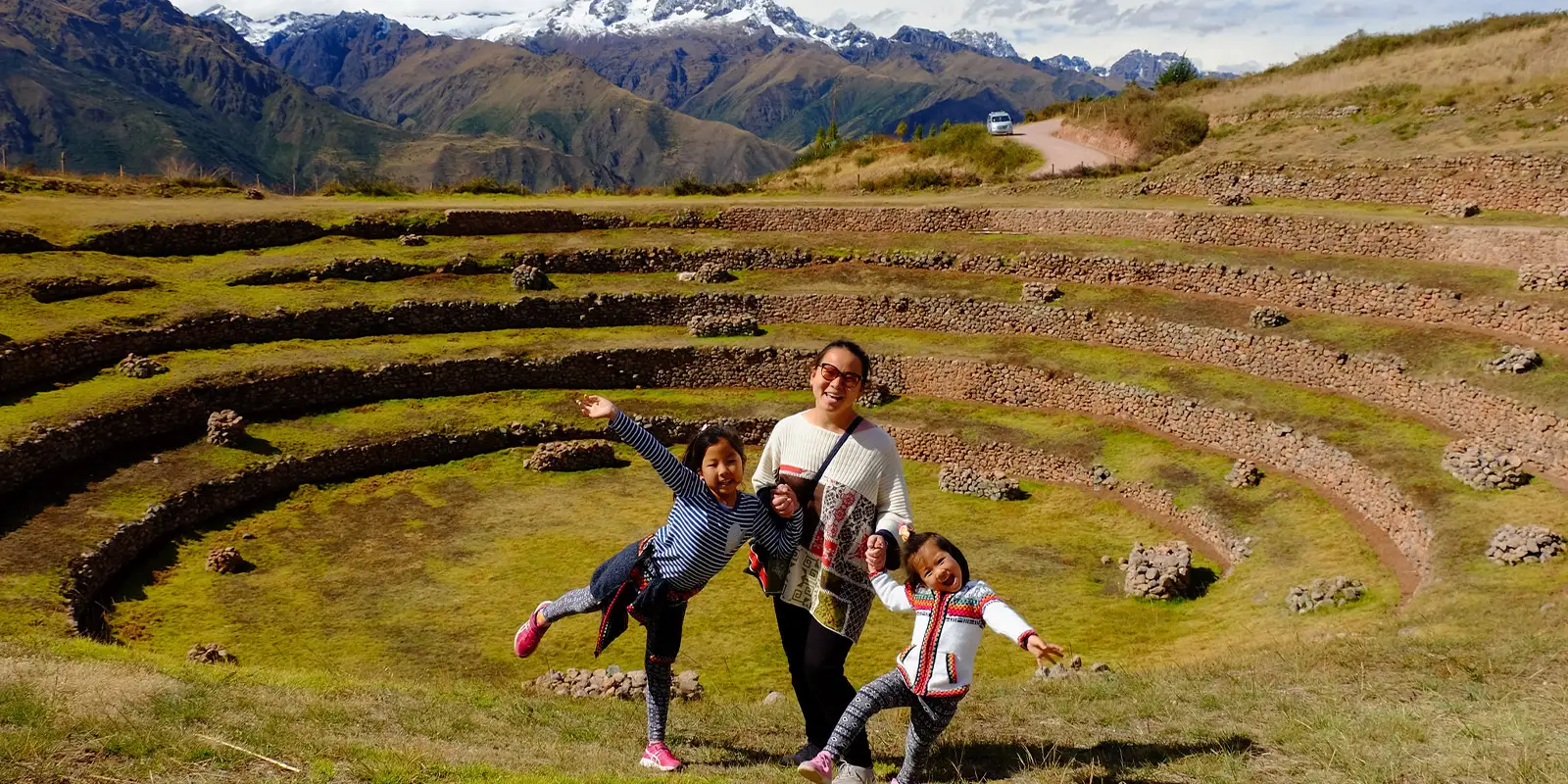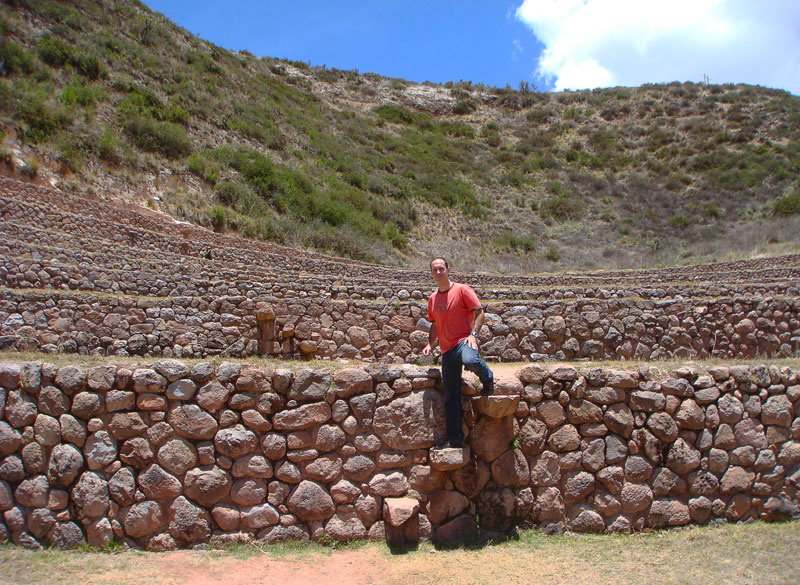
About Moray Inca Ruins in the Sacred Valley of the Incas.
Moray is one of the famous Inca ruins near Cusco. It is composed of four groups of circular terraces (muyus in Quechua) that descend 490 ft (150 meters) from the highest terrace to the lowest. Each muyu has 12 levels of terraces with the largest depression having a diameter of 600-ft. Surrounded by the towering Andes mountains, looking into the depths of these man made craters will fill you with awe and wonder.
Theories of Moray’s Purpose
With the Incas having no written language, the Moray ruins are an enigma. Their purpose has encouraged debate between anthropologists, archaeologists, and curious travelers for nearly a century, but four popular theories persist.
Agricultural Research
It is widely believed that the Moray ruins were used as an experimental farm (Green-houses) by the Incas over 500 years ago. This theory was first proposed by anthropologist John Earls in 1975 and officially published in 1981. He supported this theory with several findings after spending weeks living at the site.
Firstly, an Inca irrigation system, a series of channels fed by water from a reservoir located higher in the mountains, was engineered into the structures of terraces. He also noticed that the temperature difference from top to bottom ranged an astonishing 27 degrees Fahrenheit (12 degrees Celsius). He also observed that the sun hit each terrace at different angles and intensities.
Earl’s theory was that the Inca Empire used each terrace at Moray as its own microclimate. This allowed the Incas to study the effects of altitude, temperature, and sun absorption on crop growth to determine ecological niches suitable for crops to thrive. This experimentation allowed for the Incas to teach neighboring regions agricultural techniques for best crop production despite the differing altitudes and climates throughout the Andes and Peru. Earl’s theory illustrates how the Incas used their understanding of the environment to capitalize on the natural resources at their fingertips and it gives insight as to how the mighty Inca Empire expanded itself so widely throughout South America.
Inca Ceremonial Center
Moray as an agricultural research site isn’t the only theory kicking around, though. Locals from the nearby communities tell stories that date back to Inca times of celebrations and ceremonies being held at Moray. Even today, locals gather once a year in October to celebrate Moray Raymi at the archaeological site. While it is likely that Moray was used as an amphitheater for ceremonial purposes, it seems improbable that this was its sole purpose due to its remote location far from Cusco city, at that time the heart of the Inca Empire.
Open Pit Mine
A significant amount of excavation was needed to construct the Moray ruins in such a beautiful and symmetrical way. One theory about the site is that it was once an open-pit mine used by Incan or pre Incan cultures. After the mine had been depleted, it was then covered by terraces and repurposed for Incan farming and ceremonial uses.
Moray History
Evidence from excavations at the Moray archaeological site suggests that the bottom six terraces may have been built by a culture predating the Incas. Presumably, the Wari culture who thrived from the 6th – 10th century.
What we see now of the Moray archeological complex was created during the reign of the Inca Empire between the 12th and mid-14th centuries. Though many residents of the surrounding areas knew of its existence for ages, it was brought to western attention in the 1930s. In fact, it was the same aerial expedition over Peru’s landscapes that enabled American-Peruvian researchers to observe the Nazca Lines and the Moray ruins for the very first time in modern history.
Inca Food and Agriculture at Moray

Keep reading to learn more about what the Inca Empire ate and how they grew it.
What Did the Incas farm?
Many of the ingredients found on your plate, were once farmed by the Incas. Potatoes and tubers, quinoa, and corn were big players in the agricultural scene in the Andes and likely to have played a large role at Moray, if experimentation was indeed its purpose. Another theory suggests that corn was the key crop experimented on at Moray due to its significance in religious ceremonies.
How the Moray terraces were made
Much like the Machu Picchu terraces, the Moray site has steps carved out from the slope of a mountain. These steps have been reinforced with stones and soil and allow for water drainage. Excavations of the site have shown that the Inca Empire imported soil from varying regions of Peru to Moray, furthering the theory of crop experimentation. Even guano (one of Peru’s largest exports) from coastal destinations like Paracas was brought to the Andes to fertilize the Moray terraces.
Geography
Moray is located on a high altitude plateau northwest of Cusco at an elevation of 11,500ft (3,500 m) above sea level. Surrounding this mind-boggling site are green checked-like patches of agricultural fields and snowcapped peaks off in the distance.
Weather
Climate
The highland region where Moray resides experiences fairly constant temperatures throughout the year. Snowfall is not common. Temperatures during the day are warmer and average between 65-70 F (18-21C). Average night temperatures range between 30-50 F (1-8 C).
Dry Season Vs. Rainy Season
- Dry season is from April to October. Days are usually sunny with low chances of rain. Temperatures really drop at night, so make sure to bring a jacket.
- Rainy season is from November to March. During this time, the region receives regular rainfall. Mornings are generally cloudy with light showers and afternoons and evenings can bring heavier rains. Average daytime temperatures are typically mild, but you’ll still need that warm jacket at night.
Best Time to Visit Moray
- The region’s peak season is during the dry season (April-October) when sunny blue skies are the norm. This is a very enjoyable time to do a biking or horseback riding tour.
- The rainy season (November-March) is a beautiful time to visit the Sacred Valley. Landscapes, including the grassy terraces of Moray, are brilliant shades of green at this time.
Adjusting To The Altitude
Moray is located at similar altitudes to Cusco (11,120 ft or 3,400 m). Altitude sickness is a common concern for travelers visiting the Andean region of Peru. Severe reactions to the altitude are rare and hard to predict. Most travelers experience minor side effects, including shortness of breath, nausea, headache, and loss of appetite.
Tips to help you acclimate better:
- Some travelers may consider spending their first couple nights at a hotel in the Sacred Valley instead of Cusco. The elevation of the Sacred Valley is lower, making the adjustment to the altitude less extreme.
- Take it easy the first few days at altitude. It’s best to wait at least 48 hours before taking on activities like mountain biking through Maras and Moray.
- Drink a lot of water and eat light meals. A local remedy to ease the effects of altitude is to sip on coca tea.
- Diamox is a prescription drug from the US and works well for altitude sickness. Over-the-counter remedies, such as Sorochi and Grovol, can be purchased at a pharmacy in Peru.
What to do in Moray Peru
Feel the temperature difference
As you explore the Moray archaeological site from a lookout point near the entrance, you get a true sense of the magnitude of its design. The sweeping view over the largest set of terraces descends 490 feet (150 meters) to its circular bottom and visitors far below look like ants. As you descend with your guide and walk between each terrace level, the difference in temperature is evident.
Mountain Biking & ATV tours
The dirt trails traversing the open landscapes of the Sacred Valley are an outdoor lover’s dream. One of the most exciting mountain biking and quad biking routes goes to Maras and Moray. After an hour’s car ride from Cusco to Chinchero, you’ll suit up for the ride of your life. Moray is the first stop, and then Maras. Your tour leader will guide you through each of the sites and keep you safe along the way. Mountain biking is a great activity for all ages, though folks should be prepared for the physical effort.
See the detailed itinerary for the Mt bike tour here!
Horseback Riding
If you like horses, then you are going to love a horseback riding adventure tour to Moray, Maras, and other off the beaten path highlights. It’s an easy trail so riders with little or no experience need not worry. After a pick-up from your hotel, transfer to the Andean community of Picsuyo in the Sacred Valley. Here you will meet your horse and begin the uphill 1-hour ride to the highest point in the trail. Soak up views of the snow-clad peaks of Pitusiray, Chicon and Veronica peaks as your riding group continues along the high mountain plateau to Moray. After lunch, continue onto Maras.
Maras Salt Pans
The salt mines near Moray are salt-encrusted ponds that look like a blanket of snow covering the mountainside at a distance. But as you get closer, each of the 3,000 plus ponds takes on various shades of white or tan from the differing levels of saltwater. Maras salt has been harvested since pre-Inca times and today travelers are invited to see this centuries-old tradition at work.
Hiring a tour guide to explain the salt-making process and answer your questions is the best way to enhance your appreciation of the site. Vendors at the site entrance sell packaged Maras salt that make excellent souvenirs.
Location: 4.3 mi (7 km) from Moray
Maras Town
The town of Maras is about halfway between the Maras Salt Pans and Moray in a remote region of the Sacred Valley. Unlike the tourist buzz in Ollantaytambo, the small town offers an intimate look at what daily life is like for rural residents in the Sacred Valley.
Families living in Maras have worked the nearby salt pans since Inca times and grow crops in the surrounding fields. Women wearing traditional hats stroll through streets lined by small shops and private residences made of sun-dried mud brick. If you visit the town with a tour guide, they’ll likely point out the coat of arms from Spanish nobility etched into the stone doorways of many Maras homes, echoing its colonial past.
How to get to Moray
Moray is located 33 miles (53 km) outside of Cusco and can be visited on a day trip from Cusco or the Sacred Valley. The turnoff for Moray is along the two-lane highway connecting Cusco and the town of Urubamba in the Sacred Valley.
The distance from Moray to Machu Picchu is 26 miles (42 km) but these two iconic sites must be visited on two separate days due to train schedules to and from Machu Picchu.
Transportation to Moray from Cusco or your Sacred Valley hotel will be included in your Peru for Less travel package. Contact one of our Travel Agents today to plan your visit to the Moray ruins and Machu Picchu.
What to Bring for Visiting Moray
Enjoy the Moray ruins without forgetting the essentials. Make sure to have these items handy during your Moray tour.
- Cusco Tourist Ticket also called the Boleto Turistico (required for Moray entrance)
- Bottled water and snacks
- Comfortable walking shoes
- Camera
- Money for souvenirs
- Sun protection (hat, glasses, sunblock)
- Waterproof jacket or rain poncho (especially during the rainy season)
This unique information has been updated on March 2023!